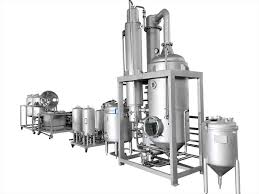Exploring the Basics of Coffee Spray Dryers
A coffee spray dryer is a pivotal piece of equipment in the instant coffee production line. It transforms liquid coffee concentrate into a dry powder through a rapid drying process, crucial for preserving flavor, aroma, and color.
How It Operates
Here’s how a coffee spray dryer functions:
- Liquid Feed Introduction: Coffee extract in liquid form is pumped into the dryer.
- Atomization: The liquid is atomized into fine droplets using a high-speed nozzle or rotary atomizer.
- Heat and Mass Transfer: These droplets encounter hot air as they fall through the drying chamber, leading to rapid evaporation of moisture.
- Collection of Dried Particles: The resultant coffee powder is collected at the bottom of the chamber, often with cyclone separators to enhance the recovery of fine particles.
Efficiency Metrics: Speed and Temperature Control
Efficiency in coffee spray dryers hinges on the balance between drying speed and temperature. Typical operational temperatures range from 120°C to 300°C. The ideal conditions ensure the coffee dries swiftly, preventing heat damage and retaining its best qualities.
Capacity and Scale
The capacity of coffee spray dryers can be immense, with commercial units handling anywhere from 100 to 5,000 liters of liquid per hour. This scale not only supports large production volumes but also enhances the uniformity of the final product.

Why Use a Coffee Spray Dryer?
Choosing to use a coffee spray dryer comes down to several advantages:
- Speed: It completes the drying process in seconds, which is vital for large-scale production.
- Quality: Maintains the integrity of the coffee’s chemical composition.
- Scalability: Suitable for operations of varying sizes, adapting to different production demands without sacrificing efficiency.
Innovations in Spray Drying Technology
Recent technological advancements have led to improvements in energy efficiency and reduction in waste. Modern spray dryers might include:
- Recycling heat systems: Minimize energy consumption by reusing hot air.
- Improved nozzle designs: Offer better control over particle size for consistency in product texture.
Optimizing the Coffee Spray Drying Process
Producers can tweak several parameters to optimize the drying process, such as inlet air temperature, feed rate, and atomizer speed. Each factor directly influences drying efficiency and the quality of the coffee powder.
Selecting the Right Spray Dryer for Coffee
When in the market for a coffee spray dryer, consider these elements:
- Output quality: Evaluate whether the dryer can produce the desired texture and flavor profile.
- Operational costs: Factor in energy consumption and maintenance expenses.
- Ease of use: Look for user-friendly interfaces and automated process controls that simplify operations.
Final Thoughts
A coffee spray dryer is not just a machine but a crucial technology that helps preserve the delicate flavors and aromas of coffee on a large scale. For manufacturers, choosing the right spray dryer is about balancing cost, efficiency, and quality, ensuring that each cup of instant coffee delivers the rich experience consumers expect.